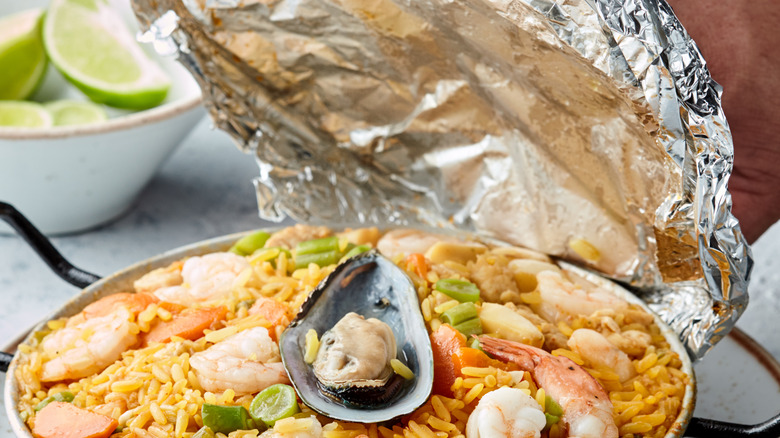When Pot Lids Just Don't Fit, Get A Tight Seal With Aluminum Foil
It's annoying when you can't find a pot lid during cooking, or when you fish one out from the depths of your cabinet only to realize it doesn't quite fit — aargh! It can be tempting to muddle through, letting valuable heat and flavor escape your pots. However, there's a simple, effective, and often overlooked solution — aluminum foil. This kitchen staple, typically reserved for wrapping leftovers or lining baking trays, can be a game-changer when you need to create a tight seal on pots and pans.
Why does this matter? Firstly, a sealed lid is crucial for certain cooking methods. These include those that rely on wet heat or consistent temperature, like simmering, steaming, braising, poaching, or boiling. A pot of rice needs a lid that fits, for example. A badly-fitting lid can lead to uneven cooking, moisture loss, and extended cooking times, which could impact the texture and flavor of your dish. This is where aluminum foil comes to the rescue.
Aluminum foil is versatile due to its malleability. It can be molded to fit virtually any shape, making it ideal to create a makeshift lid for any pot or pan. Here's how to do it: Tear off a large piece of aluminum foil, enough to cover the pot's opening with excess to fold over the sides. Press the foil down over the pot's rim, molding it to conform to the shape. For added security, you can fold the edges around the rim to fully lock in heat and moisture.
Pros and cons of using aluminum foil as a lid
Using aluminum foil as a lid has multiple benefits. First, it's cost-effective. Foil is a kitchen staple in most homes, so there's no need to purchase specialized cookware. Second, it's a space-saver. Unlike bulky lids, foil can be easily stored in a drawer. Third, it's adaptable to pots and pans of all sizes. And finally, it's a quick fix for a problem that can otherwise be quite frustrating.
Of course, there are a few considerations to keep in mind. Aluminum foil is not as durable or robust as a proper lid, so it's not ideal for long-term or high-heat cooking. The foil can tear or puncture, compromising its effectiveness as a lid. Additionally, while it provides a good seal, it doesn't offer the same level of insulation as a traditional pot lid.
Also, the debate over whether there may be a potential health risk associated with using aluminum foil too much will feature in people's decision over whether or not to use it. Scientific research cited in Healthline seems to back up both sides of the argument but concludes that it is safe overall. But it may be best to avoid using it with acidic foods like tomatoes or dishes containing citrus fruits or vinegar since these ingredients can react with aluminum. In short, while aluminum foil is a handy solution for sealing pots when you don't have the right lid, it's probably best to use it cautiously.

